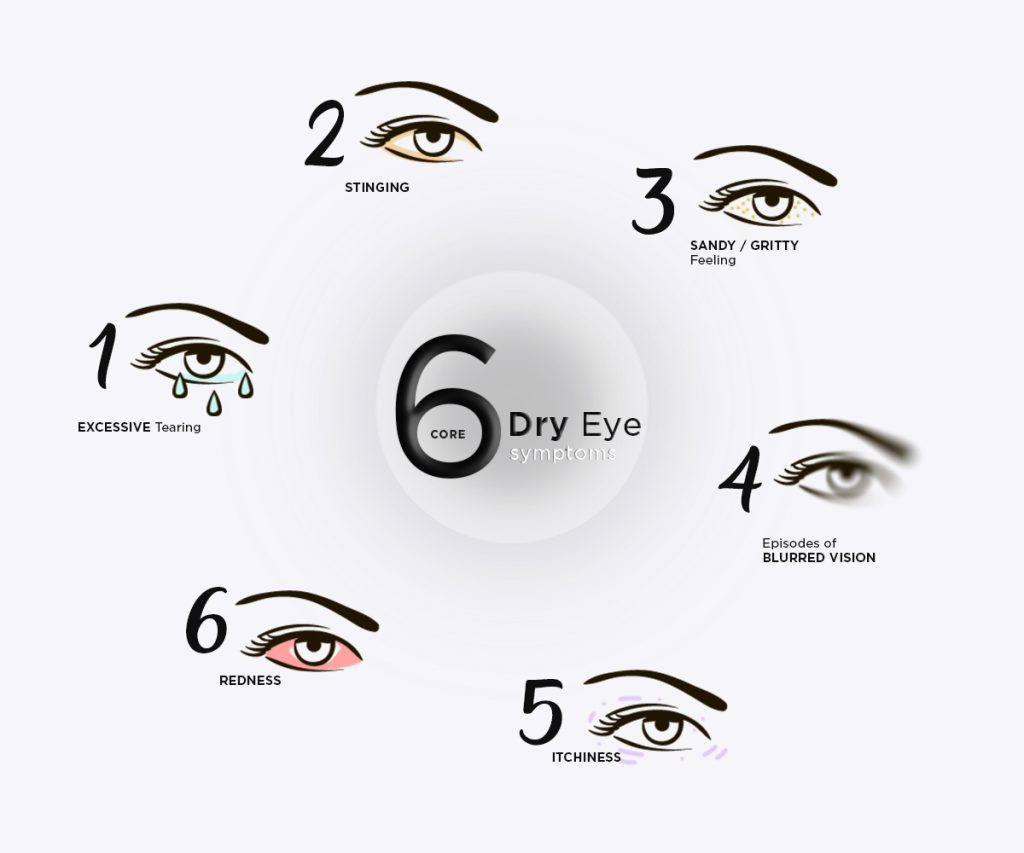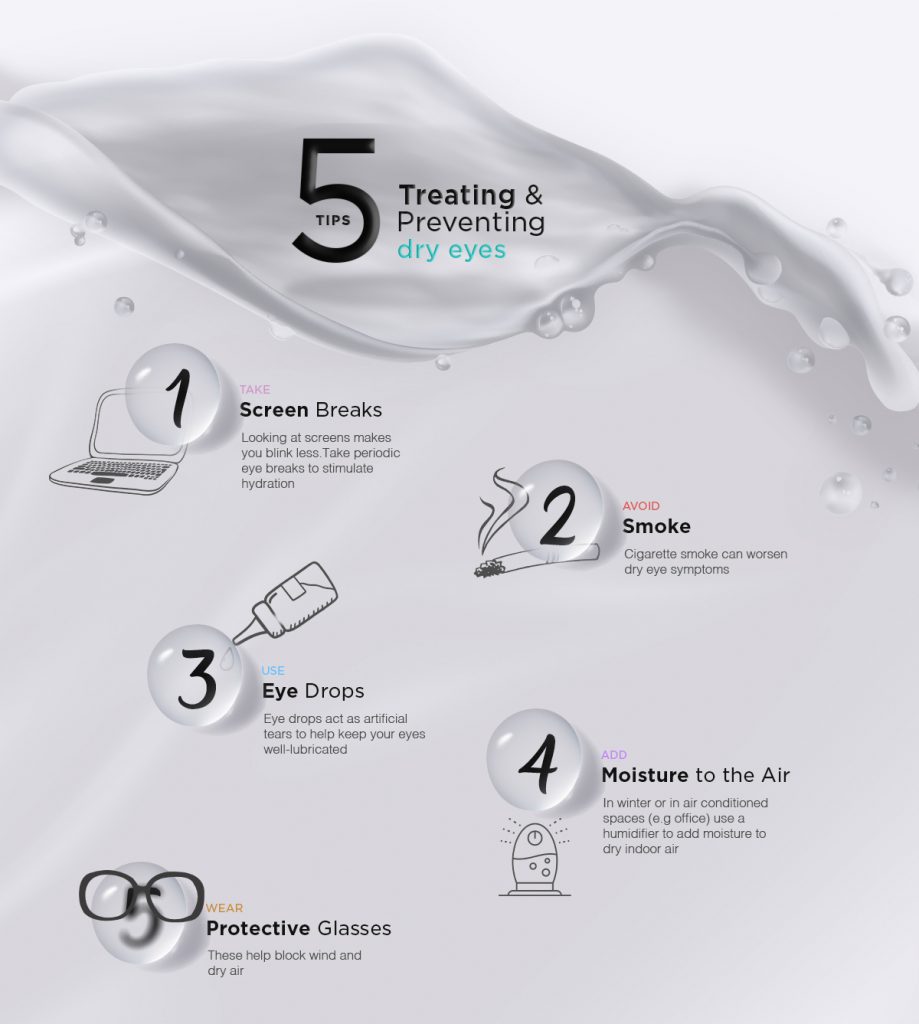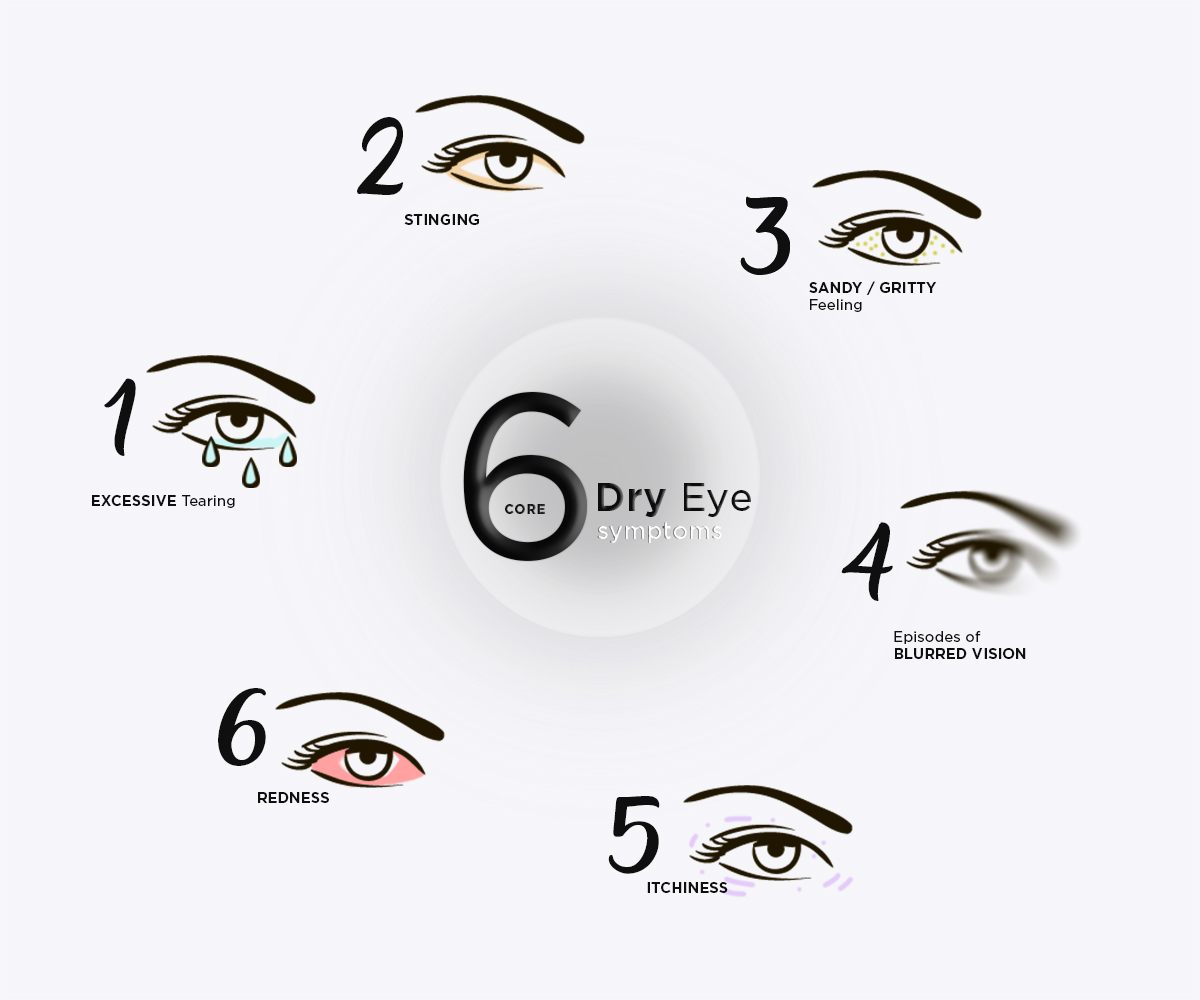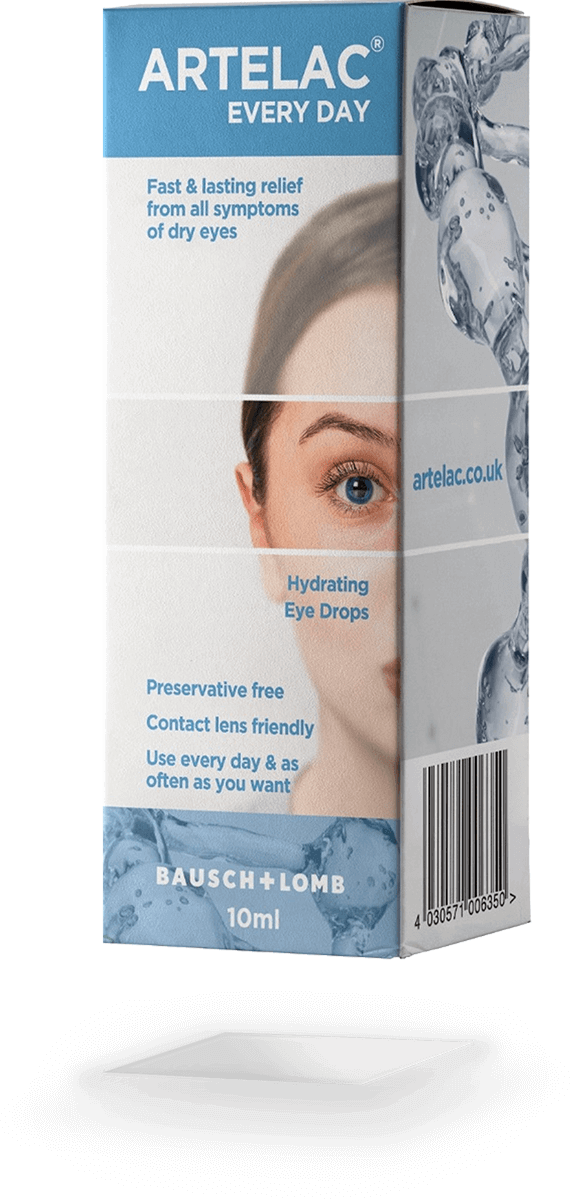If your eyes ever feel irritated and gritty then you could be suffering from Dry Eye Syndrome (DES). While there are many reasons why your eyes could be experiencing discomfort, Dry Eye Syndrome can usually be easily managed and doesn’t need to be a major cause for concern. This guide offers information regarding the symptoms, causes and treatments to help reduce dry eye discomfort.
What is dry eye syndrome?
Dry Eye Syndrome is an extremely common condition which occurs when there isn’t enough lubrication in your eyes. This can either be due to your eyes not producing enough tears or because your tears are evaporating too quickly.
It can lead to the surface of the eye becoming inflamed which further damages the cells responsible for tear production. In turn this results in a vicious circle of increasing inflammation and dryness, visual disturbance and tear film instability1.
Dry Eye Syndrome can make eyes feel very uncomfortable and you may find yourself wanting to rub them. Consequently, those suffering from chronic dry eyes also tend to suffer from subtle, but constant eye irritation. In more severe cases dry eye sufferers can also experience significant inflammation and even scarring on the front surface of the eye.
Symptoms
No matter the cause of the condition the core signs and symptoms tend to be the same:
- Excessive tearing or watery eyes: Dryness on the eye’s surface will sometimes over-stimulate tear production as a way of protecting the eye from germs and foreign objects2 3.
- Stinging: Dry Eye Syndrome causes inflammation which manifests as a stinging or burning feeling4 5.
- Grittiness: Sandy, gritty sensation in the eye also occurs due to the inflammation caused by eye dryness2 6.
- Blurred Vision: Dry Eye Syndrome occurs when the tear film evaporates too quickly, becomes too oily or gets filled with mucus4. These three factors also cause blurry vision as they prevent tears from spreading smoothly and remaining on the eye long enough to give clear, stable vision.
- Itchiness: The lack of tears analogous with Dry Eye Syndrome makes eyes more easily irritated by environmental factors and cosmetic products, resulting in an itchy sensation2.
- Redness: Like itchiness, the lack of protective tears experienced with Dry Eye Syndrome makes your eyes more susceptible to irritating factors. When irritated, the tiny blood vessels on the surface of the eyes expand and give the eyes a red appearance7.

What causes dry eye?
Dry eye occurs due to either evaporation loss or decreased tear production. There are many factors both natural and environmental which can cause or further agitate Dry Eye Syndrome. These include:
- Screens
Looking at computer screens and devices for a prolonged period of time results in a low blink rate, making it easier for tears to evaporate8.
- Environmental Stress
Environmental stress including indoor conditions such as air conditioning and heating systems decrease indoor air humidity which in turn causes tears to evaporate faster, leading to dry eye symptoms. Being exposed to air conditioning or heating can also lead to chronic inflammation of the conjunctiva which further exacerbates Dry Eye Syndrome2,9.
- Weather
Harsh weather conditions can reduce the natural moisture in your eyes. Hot and cold climates and dry or windy conditions can negatively impact the eye’s tear film, which often leads to dry eyes9.
- Contact lens wearers
Contact lenses can impact the eye’s natural moisture and cause Dry Eye Syndrome. This is because when you wear lenses, the thin layer of material sits on the tear film on the cornea and can cause it to split, resulting in a destabilisation of the tear film.10
- Smokers and alcohol drinkers
Smoking tobacco irritates and worsens dry eye. Those who smoke are twice as likely to have dry eyes as non-smokers11. Studies have also shown an increased risk of Dry Eye Syndrome linked to alcohol consumption due to ethanol being found in tears12.
- Ageing
Studies have shown the likelihood of developing Dry Eye Syndrome increases in men and women over the age of 50 due to the natural decrease in tear production that comes with ageing-related hormone changes.13
- Pregnancy and menopause
Oestrogen levels directly impact the tear film of your eyes. When hormone levels fluctuate during pregnancy and menopause, this has an adverse effect on the natural moisture of your eyes14.
- Omega-3 deficiency
Research has found fewer dry eye symptoms in people who consume omega-3 fatty acids than those who don’t. Omega-3 fatty acids can improve the eye’s oil film which improves dry eye symptoms and reduces the need for artificial tears15. You can get fish oil in your diet either from consuming omega-3 supplements or by eating fish at least twice a week. Good sources of omega-3 include fatty fish such as catfish, halibut, salmon, seabass and tuna.
- Gland dysfunction
Eye glands are located in the upper and lower eyelid and they are responsible for releasing oils onto the surface of the eye. These oils help keep tears from evaporating too quickly, keeping the tear film well-hydrated. When these glands become blocked, they don’t secrete enough oil into the tear, and as a result tears evaporate too quickly, causing dry eyes. People over the age of 40 are more likely to develop gland dysfunction16.
- Allergies
When you have an allergic reaction to something such as pollen, the symptoms can be very similar to that of dry eye. However, with allergies, eyes may feel far more irritated as histamine is released, causing eyes to become more itchy, teary and red17.
- Vitamin A deficiency
Vitamin A plays an important role in eye health and helps protect the surface of the eye, which is essential for good vision. A lack of the nutrient can cause the cornea to become dry, leading to clouding and in extreme cases, loss of vision18. Carrots, sweet potatoes, kale and spinach are all good sources of Vitamin A so make sure to get plenty of these in your diet.
- Medicine
Side effects of prescription medicine such as antihistamines, beta blockers and diuretics2 can often result in Dry Eye Syndrome. Always make sure to read your medicine information leaflet. If dry eye symptoms are causing too much discomfort, consult your doctor who may be able to prescribe a different medication. Alternatively, you should be able to manage Dry Eye Syndrome using our prevention and treatment methods below.
Prevention and treatment
Dry Eye Syndrome has a variety of causes, thereby a variety of approaches can be used to treat and prevent it.
Here is a list of steps most commonly recommended by eyecare practitioners to manage and prevent Dry Eye Syndrome symptoms. Depending on the cause and severity of your dry eye, your eyecare practitioner may advise a combination of these treatments.

1. Screen breaks
Take regular breaks when looking at a computer screen and move your screen to eye level to avoid straining your eyes. Following the 20-20-20 rule can help you take breaks as often as required to ease your dry eye symptoms. Every 20 minutes spent using a screen, look away at something that is 20 feet away from you for a total of 20 seconds. This will help you maintain a normal blink rate, keeping your eyes well-hydrated19.
2. Avoid smoke
Tobacco smoke is a known eye irritant and worsens dry eye symptoms even amongst second-hand smokers11. The best method of treating and preventing Dry Eye Syndrome causes by smoke is to avoid tobacco smoke altogether. If this is not possible, however, you can manage dry eye symptoms by using eye drops before you’re around smoke. These will coat your eyes to protect them against smoke and prevent symptoms.
3. Use eye drops
Some eye drops for dry eyes contain ingredients that help support the eye’s lipid layer which in turn slow down tear evaporation. Using eye drops regularly helps lock in natural moisture and soothe dry, irritated eyes.
4. Increase moisture
Using air humidifiers in dry, air-conditioned indoor environments can help you maintain normal tear production and prevent Dry Eye Syndrome. Staying hydrated is also important, so ensure you drink six to eight glasses of fluid every day20.
5. Wear protective glasses
Dry eye glasses have an eye cup that rests comfortably around your eye and helps slow down the evaporation of tears. These are particularly helpful for people who lead an active lifestyle as they act as barriers against wind and other drying factors21.
References
- Yi Wei and Penny A. Asbell, 2014. The core mechanism of dry eye disease (DED) is inflammation. NCBI [e-journal] 40(4), pp. 248-256. https://www.ncbi.nlm.nih.gov/pmc/articles/PMC4231828/
- NHS: Dry eyes. Available online at: https://www.nhs.uk/conditions/dry-eyes/ Accessed on: October 2019
- Eye Institute: Watery eyes. Available online at: https://www.eyeinstitute.co.nz/about-eyes/a-to-z-of-eyes/symptoms/watery-eyes Accessed on: March 2020
- Mayoclinic: Dry Eyes. Available online at: https://www.mayoclinic.org/diseases-conditions/dry-eyes/symptoms-causes/syc-20371863?page=0&citems=10 Accessed on: February 2020
- Medical News Today: Burning eyes – Causes and home remedies. Available online at: https://www.medicalnewstoday.com/articles/321739#diagnosis Accessed on: March 2020
- Very Well Health: Dry and Gritty Eyes Causes and Treatments. Available online at: Accessed on: https://www.verywellhealth.com/gritty-sensation-in-eyes-3421997 March 2020
- Best Practice Journal (BPAC), 2013. Causes, complications and treatment of a red eye. [pdf] Available at: https://bpac.org.nz/BPJ/2013/August/docs/BPJ54-pages8-21.pdf [Accessed on: February 2020]
- Amy L Sheppard and James S Wolffsohn, 2018. Digital eye strain: prevalence, measurement and amelioration. BMJ Open Ophthalmology [e-journal] 3(1). doi: http://dx.doi.org/10.1136/bmjophth-2018-000146
- Johnny L Gayton, 2009. Etiology, prevalence, and treatment of dry eye disease. NCBI, [e-journal] 3, pp. 405-412 https://www.ncbi.nlm.nih.gov/pmc/articles/PMC2720680/
- Miriam Kopf, Fan Yi, D. Robert Iskander, Michael J. Collins, Alyra J. Shaw, and Benjamin Straker, 2008. Tear Film Surface Quality with Soft Contact Lenses Using Dynamic Videokeratoscopy. NCBI, [e-journal], 1(1), pp. 14-21. https://www.ncbi.nlm.nih.gov/pmc/articles/PMC3972648/
- Jyothi Thomas, George P. Jacob, Lekha Abraham and Babu Noushad, 2012. The effect of smoking on the ocular surface and precorneal tear film. NCBI [e-journal] 5(4), pp. 221-226. https://www.ncbi.nlm.nih.gov/pmc/articles/PMC3395277/
- Yong-Sheng You, Nai-Bin Qu, and Xiao-Ning Yu, 2016. Alcohol consumption and dry eye syndrome: a Meta-analysis. NCBI, [e-journal] 9(10), 1487-1492. https://www.ncbi.nlm.nih.gov/pmc/articles/PMC5075667/
- Cintia S. de Paiva, 2018. Effects of aging in dry eye. NCBI, [e-journal] 57(2), pp. 47-64. https://www.ncbi.nlm.nih.gov/pmc/articles/PMC5347479/
- Travis Peck, Leslie Olsakovsky, and Shruti Aggarwal, 2017. Dry Eye Syndrome in Menopause and Perimenopausal Age Group. NCBI, [e-journal] 8(2), pp. 51-54. https://www.ncbi.nlm.nih.gov/pmc/articles/PMC5496280/
- NHS: Water, drinks and your health. Available online at: https://www.nhs.uk/live-well/eat-well/water-drinks-nutrition/ Accessed on: October 2019
- Ogawa M., Dogru M, Toriyama N, Yamaguchi T, Shimazaki J, Tsubota K., 2018. Evaluation of the Effect of Moist Chamber Spectacles in Patients With Dry Eye Exposed to Adverse Environment Conditions. NCBI [e-journal] 44(6), pp 379-383. https://www.ncbi.nlm.nih.gov/pubmed/29095724
- Mayo Clinic: Fish oil supplements and dry eyes. Available online at: https://newsnetwork.mayoclinic.org/discussion/mayo-clinic-q-and-a-fish-oil-supplements-and-dry-eyes/ Accessed on: February 2020
- Oregon Eyes: Meibomian Gland Dysfunction (MGD). Available online at: https://www.oregoneyes.net/meibomian-gland-dysfunction-mgd-the-cause-of-your-dry-eyes/ Access on: March 2020
- The Eye Institute: Is it Seasonal Allergies or Dry Eye? Available online at: https://www.theeyeinstitute.com/latest-news/is-it-seasonal-allergies-or-dry-eye/ Accessed on: October 2019
- Clare Gilbert, 2013. The eye signs of vitamin A deficiency. NCBI [e-journal] 26(84), pp. 66-67 https://www.ncbi.nlm.nih.gov/pmc/articles/PMC3936686/
- Healthline: How does the 20-20-20 rule help prevent eye strain. Available online at: https://www.healthline.com/health/eye-health/20-20-20-rule#symptoms Accessed on: October 2019
- NHS: Water, drinks and your health. Available online at: https://www.nhs.uk/live-well/eat-well/water-drinks-nutrition/ Accessed on: October 2019
- Ogawa M., Dogru M, Toriyama N, Yamaguchi T, Shimazaki J, Tsubota K., 2018. Evaluation of the Effect of Moist Chamber Spectacles in Patients With Dry Eye Exposed to Adverse Environment Conditions. NCBI [e-journal] 44(6), pp 379-383. https://www.ncbi.nlm.nih.gov/pubmed/29095724

